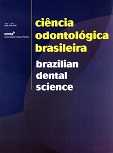Associação entre hábitos de sucção não nutritivos e as relações oclusais ântero-posteriores em crianças nipo-brasileiras
DOI:
https://doi.org/10.14295/bds.2008.v11i1.191Abstract
Este trabalho teve por objetivo avaliar a associação entre hábitos de sucção digital e/ou de chupeta e as relações oclusais ântero-posteriores em crianças nipo-brasileiras, na dentadura decídua. Um cirurgião-dentista examinou clinicamente 410 crianças (206 do gênero masculino e 204 do feminino), com 2 a 6 anos de idade, matriculadas em 36 escolas de 9 cidades no Estado de São Paulo. Questionários sobre os hábitos de sucção foram respondidos pelos pais, permitindo dividir a amostra em dois grupos: Controle (GC), com 227 crianças sem histórico de hábitos (55,4%) e Experimental (GE), com 183 crianças que apresentavam histórico positivo (44,6%). O Grupo Experimental foi dividido em três subgrupos conforme a idade de interrupção dos hábitos: SG1, até 2 anos; SG2, 2 a 4 anos e SG3, 4 a 6 anos. Os dados foram analisados por meio de testes Qui-Quadrado (p < 0,05) e de regressão logística. As prevalências de más oclusões para os três subgrupos foram de: sobressaliência aumentada - 13,1%, 32,8% e 26,7%; caninos em Classe 2 - 11,7%, 14,8% e 6,7%; degrau distal - 5,6%, 13,1% e 6,6%. Para GC, os respectivos valores foram de 13,2%, 6,2% e 4,2%. Em relação ao GC, as principais diferenças ocorreram no SG2, com odds ratios aumentados em 3,2; 2,63 e 3,45, respectivamente. Os hábitos pesquisados associaram-se significantemente com o aumento na prevalência da má oclusão de Classe 2 na dentadura decídua, particularmente dos 2 aos 4 anos de idade.Downloads
Downloads
Published
How to Cite
Issue
Section
License
Brazilian Dental Science uses the Creative Commons (CC-BY 4.0) license, thus preserving the integrity of articles in an open access environment. The journal allows the author to retain publishing rights without restrictions.
=================




























